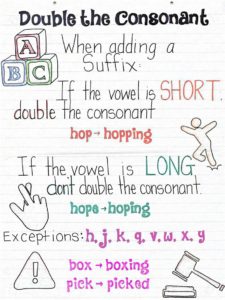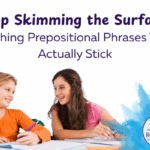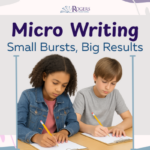** Contact us if you would like Rogers Education Consulting to come to your campus with engaging, evidence-based, practical professional development **
 One of my biggest inner battles when it comes to teaching is…spelling. What I knew about spelling instruction is that what I was doing wasn’t working. I was locating lists of words based on spelling patterns I needed to teach (based on my state standards). The lists of words came from lots of places: our spelling adoption, the week’s reading, online searches, co-workers, or my own brain. The students were busy throughout the week studying the words, memorizing how to spell the words on their lists (differentiated for different levels of spellers in my class, of course), sorting the words in stations, and completing other activities like word pyramids, writing stories and sentences with the word, etc. I would give the students their test on Friday, the same students always passed, usually because their parents would spend a significant amount of time quizzing them throughout the week. The flip side was that the same students who didn’t perform well week after week continued to perform poorly on the tests. Then within a few weeks, no one would know how to spell the words I taught and few could remember the spelling rule that was taught. I knew this was a waste of time. I heard countless times at professional development that spelling lists didn’t work. But I had also read the research explaining how important spelling is for reading achievement as well as for writing. So I began a personal journey of trying to find the perfect way to teach spelling so that it sticks.
One of my biggest inner battles when it comes to teaching is…spelling. What I knew about spelling instruction is that what I was doing wasn’t working. I was locating lists of words based on spelling patterns I needed to teach (based on my state standards). The lists of words came from lots of places: our spelling adoption, the week’s reading, online searches, co-workers, or my own brain. The students were busy throughout the week studying the words, memorizing how to spell the words on their lists (differentiated for different levels of spellers in my class, of course), sorting the words in stations, and completing other activities like word pyramids, writing stories and sentences with the word, etc. I would give the students their test on Friday, the same students always passed, usually because their parents would spend a significant amount of time quizzing them throughout the week. The flip side was that the same students who didn’t perform well week after week continued to perform poorly on the tests. Then within a few weeks, no one would know how to spell the words I taught and few could remember the spelling rule that was taught. I knew this was a waste of time. I heard countless times at professional development that spelling lists didn’t work. But I had also read the research explaining how important spelling is for reading achievement as well as for writing. So I began a personal journey of trying to find the perfect way to teach spelling so that it sticks.
After much study and reflection, a few truths rose to the surface:
- I personally don’t see any benefit in students memorizing a list of random words for a test at the end of the week. Full disclosure – I DO think that memorization is an important skill, just not for random words.
- I want students to understand the rules and patterns. Of course, we will always talk about the exceptions to the rule, but I want my students to know the standard rules.
- I want the words and patterns being learned to have value to the students and I want them to stick. It is important to me to have a high level of student retention.
So I started backward and created a new way to teach spelling in my class.
- I took time and brushed up on the spelling patterns I was supposed to teach according to the curriculum. Then I searched through all my students’ writing looking for the types of errors students were making. The top five errors being made for my students were:
- The Y Rule: leaving the y when adding ing
- Doubling the Consonant: when adding a suffix
- The “ie” Rule: i before e, except after c
- Apostrophe with Plural: okay, maybe not so much spelling as grammar, but fine line and it needed to be taught!
- Adding ‘ly’ and ‘ful’ to words
Since the students were trying to use these rules, but unsuccessfully, in their writing, I felt they would be the most beneficial to teach first.
- Now that I had selected the patterns that would be the most beneficial to my students, I had to research exactly what the rules were. Yes, I can spell. Yes, I know the rules. Yes, at some point I probably learned these rules. But now they are automatic for me and I haven’t thought about the actual rule in a long time. Set aside the feeling that, as a teacher, you should already know everything and Google it! If I am to teach this rule well to the students I need to make sure I know it REALLY well. Next, instead of beginning a spelling lesson by sharing a list of words and talking about the rule on the side, I am just going to talk about the rule and show maybe one or two example words. I am going to EXPLICITLY teach the rule, NOT words.
- The explicit instruction for Doubling the Consonant might go like this;
- Monday – After reviewing short vowel sounds and long vowel sounds, “When a short vowel is followed by one consonant at the end of a root word, double the last consonant and add ‘ed’ or ‘ing’. Let’s take the word hop. If I want to make the word hopped or hopping, I have to double the p which is the consonant, because the vowel is short. When a long vowel is followed by one consonant at the end of the root word, DON’T double the last consonant and add ‘ed’ or ‘ing’. Take the word hope. The vowel is long, so you don’t double to the p to make hoped or hoping.” Then give the student groups different words and have them practice adding ed and/or ing.
- Tuesday – Review yesterday’s lesson. Then teach students that verbs that end in the letter ‘x’ are not doubled. Practice with words mix and box. Model how to add suffixes.
- Wednesday – Review all previous rules and a few words. Then teach another exception to the rule. We never double the consonant with words ending in h, j, k, q, v, w, x, or y. Model a few words and then in stations, have students practice with these rules. I modeled on the word grow and lick.
- Thursday – continue to practice with the rules and exceptions.

- The explicit instruction for Doubling the Consonant might go like this;
- On Friday we will test the rule. I never gave the students a list of words. I don’t really want them memorizing words, I want them learning the rules and patterns. So we had words that we practiced with throughout the week and I gave the parents a typed sheet with the rules and few words (totaling no more than five) that demonstrate the rules. The spelling test will total 15 words: 10 that follow the rule of the week, with five that review previously taught rules. Personally, I only grade the rules I taught or have taught. If the students make a spelling error, but it isn’t a rule I taught I don’t take points off. I write the word correctly for them but don’t subtract points. If I haven’t taught it, I can’t grade it! An example might be the student who is learning the ie rule and they spell the word receive like this: riceive. They understand the rule I was teaching, so I wouldn’t take points off, I would just write the word correctly for them.
Teaching this way was a small learning curve for my parents and students, but what I have seen is that my students have become better spellers and readers! I feel that my students are learning more this way.
How do you teach spelling?


